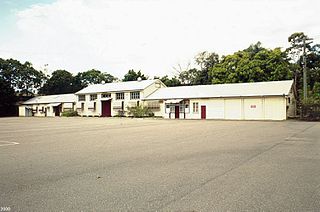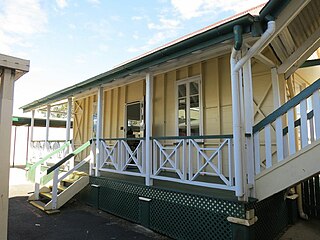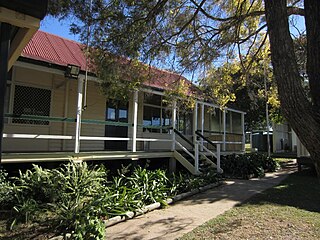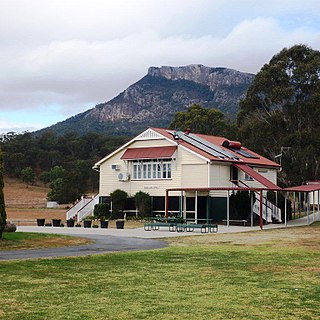
Glenmore Homestead is a heritage-listed homestead at Belmont Road, Parkhurst, Rockhampton Region, Queensland, Australia. It was built from c. 1858 to c. 1920. The homestead and associated buildings once belonged to pastoral run on the Fitzroy River, seven kilometres northwest of Rockhampton, Queensland. Originally much larger at 127 square miles the current size of the property is 20 acres (8.1 ha). It was added to the Queensland Heritage Register on 21 October 1992.

Maryborough Central State School is a heritage-listed state school at 471 Kent Street, Maryborough, Fraser Coast Region, Queensland, Australia. It was built from 1875 to 1953. It is also known as Central State School for Boys, Central State School for Girls, and Central State School for Infants. It was the first state school in Maryborough and was established with separate girls and boys departments. It is the oldest public school in Queensland. It was added to the Queensland Heritage Register on 31 October 1994.

University of Queensland Gatton Campus is a heritage-listed university campus of the University of Queensland at Warrego Highway, Gatton, Queensland, Australia. It was built from 1897 to 1960s. It is also known as the Queensland Agricultural College, the Foundation Precinct Gatton College and Lawes Campus. It was added to the Queensland Heritage Register on 6 January 2004.

Springbrook State School is a heritage-listed former state school in Springbrook National Park at 2873 Springbrook Road, Springbrook, Gold Coast City, Queensland, Australia. It was designed by Department of Public Works and built from 1911 to 1953. It is also known as Queensland Parks and Wildlife Service Information Centre and is now part of the national park. It was added to the Queensland Heritage Register on 5 August 2003.

Hemmant State School is a heritage-listed state school at 56 Hemmant-Tingalpa Road, Hemmant, City of Brisbane, Queensland, Australia. It was built from 1876 to 1930s. Its architects included Francis Drummond Greville Stanley. It was also known as Bulimba Creek School and Doughboy Creek Mixed School. On its grounds is the historic house Dumbarton, also known as Ashcroft House and Gibson House. The original Hemmant State School closed at the end of 2010, and in 2012 was replaced by the Hemmant Flexible Learning Centre, a new school targeted at students disengaged from mainstream education. The school buildings and structures were added to the Queensland Heritage Register on 4 September 2003.

Sinnamon Farm is a heritage-listed farm at 645 & 693 Seventeen Mile Rocks Road, Sinnamon Park, City of Brisbane, Queensland, Australia. It was built from 1869 to 1890s. It is also known as Avondale & Macleod aviation site, Beechwood, Glen Ross, and Seventeen Mile Rocks School. It was added to the Queensland Heritage Register on 21 October 1992.

Maryborough railway station is a heritage-listed railway station at Lennox Street, Maryborough, Fraser Coast Region, Queensland, Australia. It is on the North Coast line serving the city of Maryborough. It was designed by Chief Engineer of the Queensland Railways Department and built from 1878 to 1890 by John Roddam & John Walker. It was added to the Queensland Heritage Register on 21 October 1992.

Gona Barracks is a heritage-listed barracks at 3, 7, 12, 25 & 26 Gona Parade, Kelvin Grove, City of Brisbane, Queensland, Australia. It was built from c. 1914 to 1960s. It is also known as Kelvin Grove Military Reserve and Kelvin Grove Training Area. It was added to the Queensland Heritage Register on 7 February 2005.

Tallegalla State School is a heritage-listed former state school at Rosewood-Minden Road, Tallegalla, City of Ipswich, Queensland, Australia. It was built from 1879 to 1955. It was added to the Queensland Heritage Register on 2 February 1998.

Warwick railway station is a heritage-listed railway station on the Southern railway line in Warwick, Southern Downs Region, Queensland, Australia. It was built from c. 1881 to 1910s. It was added to the Queensland Heritage Register on 24 September 1999.

Longreach railway station is the terminus station of the Central Western line, serving the town of Longreach, Longreach Region, Queensland, Australia. It is on the Landsborough Highway. It was built from 1887 to 1917. It was added to the Queensland Heritage Register on 12 December 2005.

North Pine Presbyterian Church is a heritage-listed former Presbyterian and now Lutheran church at Dayboro Road, Whiteside, City of Moreton Bay, Queensland, Australia. The church was built from 1883 to 1884 and was added to the Queensland Heritage Register on 21 October 1992.

Strathmore Homestead is a heritage-listed homestead at Strathmore Station on Strathmore Road, Springlands, Whitsunday Region, Queensland, Australia. It was built from the 1860s onward. It is also known as Strathmore Station. It was added to the Queensland Heritage Register on 13 November 2008.
Mitchell State School was a heritage-listed state school building at 105 Cambridge Street, Mitchell, Maranoa Region, Queensland, Australia. It was designed by Department of Public Works (Queensland) and built from 1913 to 1920 by G P Williams. It is also known as the 1914 Building. It was added to the Queensland Heritage Register on 6 June 1994.

Morayfield State School is a heritage-listed state school at 196–230 Morayfield Road, Morayfield, City of Moreton Bay, Queensland, Australia. It was designed by Richard George Suter and built in 1873 by Robert Monteith. It is also known as Caboolture National School and Caboolture South State School. It was added to the Queensland Heritage Register on 10 October 2014.

Mutdapilly State School is a heritage-listed state school at 4 Mutdapilly-Churchbank Weir Road, Mutdapilly, Scenic Rim Region, Queensland, Australia. It was designed by Richard George Suter and built from 1874 to 1880 by William Adams and Ben Denman. It is also known as Normanby National School. It was added to the Queensland Heritage Register on 10 October 2014.

Cannon Hill State School is a heritage-listed state school at 845 Wynnum Road, Cannon Hill, City of Brisbane, Queensland, Australia. It was added to the Queensland Heritage Register on 12 June 2015.

Lake Clarendon State School is a heritage-listed state school at 35 Lake Clarendon Road, Lake Clarendon, Lockyer Valley Region, Queensland, Australia. It was built from 1901 to 1902 by Patrick Fagan. It was added to the Queensland Heritage Register on 12 June 2015.

Maroon State School and Maroon War Memorial is a heritage-listed state school and war memorial at 2772 Boonah Rathdowney Road, Maroon, Scenic Rim Region, Queensland, Australia. It was built in 1910. It was added to the Queensland Heritage Register on 9 October 2015.

Wellcamp State School is a heritage-listed state school at 609 Drayton-Wellcamp Road, Wellcamp, Toowoomba Region, Queensland, Australia. Block A was designed by Department of Public Works (Queensland) and built in 1911, while Block L was building in 1918. It was added to the Queensland Heritage Register on 27 March 2020.





















